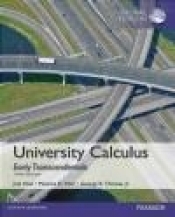334.01
Książki
Pearson
University Calculus, Early Transcendentals
Wydawnictwo:
Pearson
Oprawa: Miękka
Opis
For 3-semester or 4-quarter courses in calculus for math, science, and engineering majors. University Calculus, Early Transcendentals, Third Edition helps students generalize and apply the key ideas of calculus through clear and precise explanations, thoughtfully chosen examples, meticulously crafted figures, and superior exercise sets. This text offers the right mix of basic, conceptual, and challenging exercises, along with meaningful applications. This revision features more examples, more mid-level exercises, more figures, improved conceptual flow, and the best in technology for learning and teaching. MyMathLab is an online homework, tutorial, and assessment product designed to personalize learning and improve results. With a wide range of interactive, engaging, and assignable activities, students are encouraged to actively learn and retain tough course concepts. Please note that the product you are purchasing does not include MyMathLab. MyMathLab Join over 11 million students benefiting from Pearson MyLabs. This title can be supported by MyMathLab, an online homework and tutorial system designed to test and build your understanding. Would you like to use the power of MyMathLab to accelerate your learning? You need both an access card and a course ID to access MyMathLab. These are the steps you need to take: 1. Make sure that your lecturer is already using the system Ask your lecturer before purchasing a MyLab product as you will need a course ID from them before you can gain access to the system. 2. Check whether an access card has been included with the book at a reduced cost If it has, it will be on the inside back cover of the book. 3. If you have a course ID but no access code, you can benefit from MyMathLab at a reduced price by purchasing a pack containing a copy of the book and an access code for MyMathLab (ISBN:9781292104140) 4. If your lecturer is using the MyLab and you would like to purchase the product...Go to www.mymathlab.com to buy access to this interactive study programme. For educator access, contact your Pearson representative. To find out who your Pearson representative is, visit www.pearsoned.co.uk/replocator1. Functions 1.1 Functions and Their Graphs 1.2 Combining Functions; Shifting and Scaling Graphs 1.3 Trigonometric Functions 1.4 Graphing with Calculators and Computers 1.5 Exponential Functions 1.6 Inverse Functions and Logarithms 2. Limits and Continuity 2.1 Rates of Change and Tangents to Curves 2.2 Limit of a Function and Limit Laws 2.3 The Precise Definition of a Limit 2.4 One-Sided Limits 2.5 Continuity 2.6 Limits Involving Infinity; Asymptotes of Graphs 3. Differentiation 3.1 Tangents and the Derivative at a Point 3.2 The Derivative as a Function 3.3 Differentiation Rules 3.4 The Derivative as a Rate of Change 3.5 Derivatives of Trigonometric Functions 3.6 The Chain Rule 3.7 Implicit Differentiation 3.8 Derivatives of Inverse Functions and Logarithms 3.9 Inverse Trigonometric Functions 3.10 Related Rates 3.11 Linearization and Differentials 4. Applications of Derivatives 4.1 Extreme Values of Functions 4.2 The Mean Value Theorem 4.3 Monotonic Functions and the First Derivative Test 4.4 Concavity and Curve Sketching 4.5 Indeterminate Forms and L'Hopital's Rule 4.6 Applied Optimization 4.7 Newton's Method 4.8 Antiderivatives 5. Integration 5.1 Area and Estimating with Finite Sums 5.2 Sigma Notation and Limits of Finite Sums 5.3 The Definite Integral 5.4 The Fundamental Theorem of Calculus 5.5 Indefinite Integrals and the Substitution Rule 5.6 Substitution and Area Between Curves 6. Applications of Definite Integrals 6.1 Volumes Using Cross-Sections 6.2 Volumes Using Cylindrical Shells 6.3 Arc Length 6.4 Areas of Surfaces of Revolution 6.5 Work 6.6 Moments and Centers of Mass 7. Integrals and Transcendental Functions 7.1 The Logarithm Defined as an Integral 7.2 Exponential Change and Separable Differential Equations 7.3 Hyperbolic Functions 8. Techniques of Integration 8.1 Integration by Parts 8.2 Trigonometric Integrals 8.3 Trigonometric Substitutions 8.4 Integration of Rational Functions by Partial Fractions 8.5 Integral Tables and Computer Algebra Systems 8.6 Numerical Integration 8.7 Improper Integrals 9. Infinite Sequences and Series 9.1 Sequences 9.2 Infinite Series 9.3 The Integral Test 9.4 Comparison Tests 9.5 The Ratio and Root Tests 9.6 Alternating Series, Absolute and Conditional Convergence 9.7 Power Series 9.8 Taylor and Maclaurin Series 9.9 Convergence of Taylor Series 9.10 The Binomial Series and Applications of Taylor Series 10. Parametric Equations and Polar Coordinates 10.1 Parametrizations of Plane Curves 10.2 Calculus with Parametric Curves 10.3 Polar Coordinates 10.4 Graphing in Polar Coordinates 10.5 Areas and Lengths in Polar Coordinates 10.6 Conics in Polar Coordinates 11. Vectors and the Geometry of Space 11.1 Three-Dimensional Coordinate Systems 11.2 Vectors 11.3 The Dot Product 11.4 The Cross Product 11.5 Lines and Planes in Space 11.6 Cylinders and Quadric Surfaces 12. Vector-Valued Functions and Motion in Space 12.1 Curves in Space and Their Tangents 12.2 Integrals of Vector Functions; Projectile Motion 12.3 Arc Length in Space 12.4 Curvature and Normal Vectors of a Curve 12.5 Tangential and Normal Components of Acceleration 12.6 Velocity and Acceleration in Polar Coordinates 13. Partial Derivatives 13.1 Functions of Several Variables 13.2 Limits and Continuity in Higher Dimensions 13.3 Partial Derivatives 13.4 The Chain Rule 13.5 Directional Derivatives and Gradient Vectors 13.6 Tangent Planes and Differentials 13.7 Extreme Values and Saddle Points 13.8 Lagrange Multipliers 14. Multiple Integrals 14.1 Double and Iterated Integrals over Rectangles 14.2 Double Integrals over General Regions 14.3 Area by Double Integration 14.4 Double Integrals in Polar Form 14.5 Triple Integrals in Rectangular Coordinates 14.6 Moments and Centers of Mass 14.7 Triple Integrals in Cylindrical and Spherical Coordinates 14.8 Substitutions in Multiple Integrals 15. Integration in Vector Fields 15.1 Line Integrals 15.2 Vector Fields and Line Integrals: Work, Circulation, and Flux 15.3 Path Independence, Conservative Fields, and Potential Functions 15.4 Green's Theorem in the Plane 15.5 Surfaces and Area 15.6 Surface Integrals 15.7 Stokes' Theorem 15.8 The Divergence Theorem and a Unified Theory 16. First-Order Differential Equations (Online) 16.1 Solutions, Slope Fields, and Euler's Method 16.2 First-Order Linear Equations 16.3 Applications 16.4 Graphical Solutions of Autonomous Equations 16.5 Systems of Equations and Phase Planes 17. Second-Order Differential Equations (Online) 17.1 Second-Order Linear Equations 17.2 Nonhomogeneous Linear Equations 17.3 Applications 17.4 Euler Equations 17.5 Power Series Solutions Appendices 1. Real Numbers and the Real Line 2. Mathematical Induction 3. Lines, Circles, and Parabolas 4. Conic Sections 5. Proofs of Limit Theorems 6. Commonly Occurring Limits 7. Theory of the Real Numbers 8. Complex Numbers 9. The Distributive Law for Vector Cross Products 10. The Mixed Derivative Theorem and the Increment Theorem 11. Taylor's Formula for Two Variables
Szczegóły
Rok wydania
2016
Oprawa
Miękka
Ilość stron
1076
ISBN
9781292104034
EAN
9781292104034
Kraj produkcji
PL
Producent
GPSR Pearson Central Europe Sp. z o.o.

Dodałeś produkt do koszyka

University Calculus, Early Transcendentals
334,01 zł

Recenzje